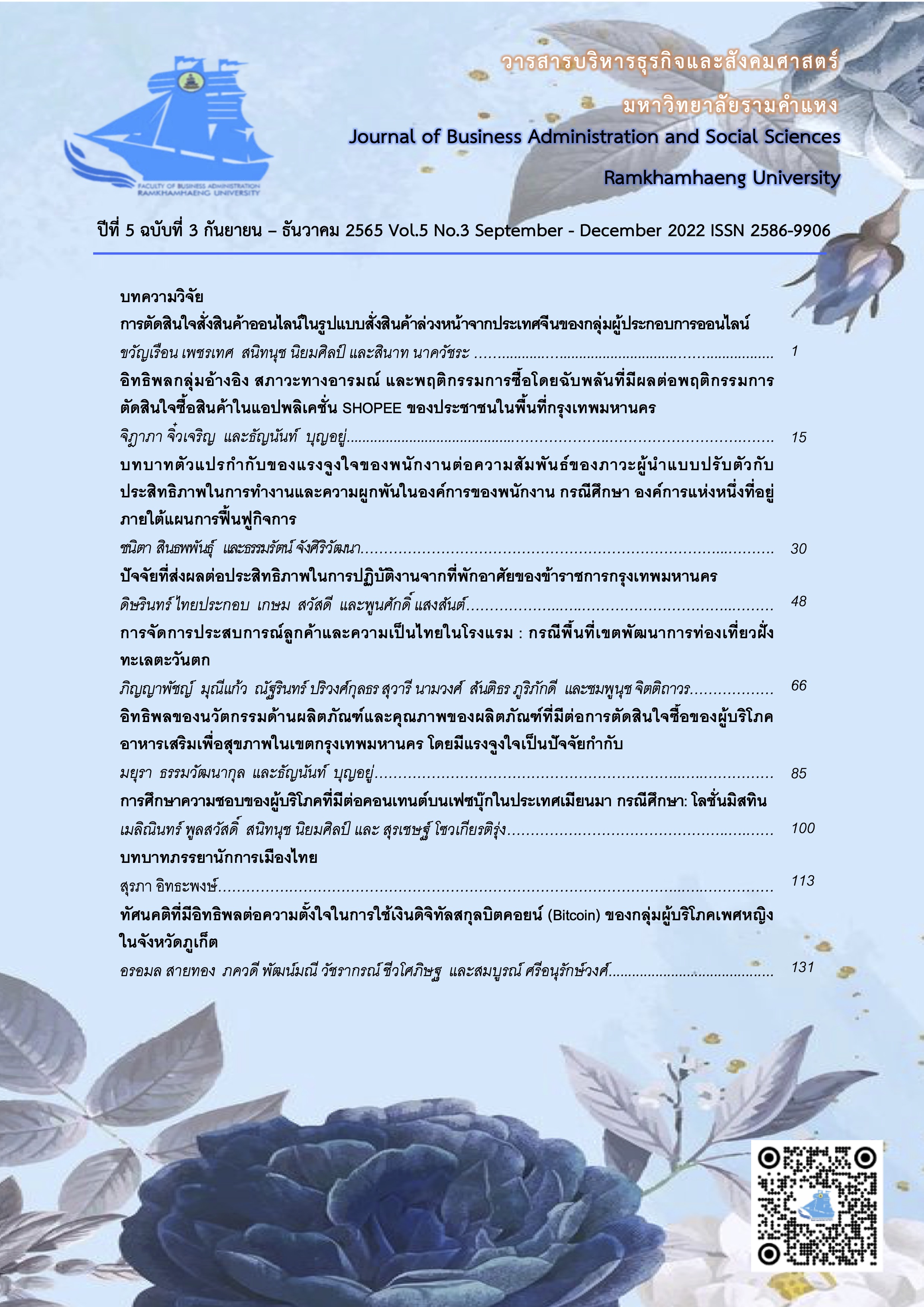อิทธิพลกลุ่มอ้างอิง สภาวะทางอารมณ์ และพฤติกรรมการซื้อโดยฉับพลันที่มีผลต่อพฤติกรรมการตัดสินใจซื้อของประชาชนในพื้นที่กรุงเทพมหานครที่ซื้อสินค้าในแอปพลิเคชัน Shopee
Main Article Content
บทคัดย่อ
การวิจัยครั้งนี้มุ่งศึกษา 1) อิทธิพลของการซื้อโดยฉับพลันที่เป็นปัจจัยคั่นกลางระหว่างอิทธิพลกลุ่มอ้างอิงสู่การตัดสินใจซื้อ และ 2) อิทธิพลของการซื้อโดยฉับพลันที่เป็นปัจจัยคั่นกลางระหว่างสภาวะทางอารมณ์การตัดสินใจซื้อสินค้าในแอปพลิเคชัน Shopee ของประชาชนในพื้นที่กรุงเทพมหานคร กลุ่มตัวอย่างที่ใช้ในการวิจัย คือ ประชาชนในกรุงเทพมหานครที่ซื้อสินค้าในแอปพลิเคชัน Shopee จำนวน 400 ตัวอย่าง ด้วยวิธีการสุ่มกลุ่มตัวอย่างแบบเฉพาะเจาะจง มีแบบสอบถามเป็นเครื่องมือวิจัย สถิติที่ใช้ คือ
การวิเคราะห์ด้วยค่าร้อยละ ค่าเฉลี่ย ส่วนเบี่ยงเบนมาตรฐาน และการวิเคราะห์สมการโครงสร้างด้วยโปรแกรมสำเร็จรูปทางสถิติ ผลการวิจัยพบว่า 1) อิทธิพลคั่นกลางของการซื้อโดยฉับพลันเป็นปัจจัยคั่นกลางระหว่างอิทธิพลกลุ่มอ้างอิงสู่การตัดสินใจซื้อ โดยมีสัมประสิทธิ์ขอบเขตล่างเท่ากับ 0.230 และขอบเขตบนเท่ากับ 0.409 และ 2) ผลการวิเคราะห์อิทธิพลคั่นกลางของการซื้อโดยฉับพลันเป็นปัจจัยคั่นกลางระหว่างสภาวะทางอารมณ์สู่การตัดสินใจซื้อ โดยมีสัมประสิทธิ์ขอบเขตล่างเท่ากับ 0.142 และขอบเขตบนเท่ากับ 0.347 ดังนั้นจากผลการวิจัยนี้แสดงให้เห็นว่า เมื่อประชาชนซื้อสินค้าในแอปพลิเคชัน Shopee ในกรุงเทพมหานครมีพฤติกรรมที่เป็นอิทธิพลกลุ่มอ้างอิงและสภาวะทางอารมณ์ในทิศทางบวกก็ จะส่งผลให้ตัดสินใจซื้อสินค้า และเมื่อประชาชนที่เป็นได้รับแรงผลักดันซื้อโดยฉับพลันก็จะส่งผลให้ตัดสินใจซื้อสินค้าที่มากขึ้นตามลำดับเช่นกัน
Article Details

อนุญาตภายใต้เงื่อนไข Creative Commons Attribution-NonCommercial-NoDerivatives 4.0 International License.
เนื้อหาและข้อมูลในบทความที่ลงตีพิมพ์ในวารสารบริหารธุรกิจและสังคมศาสตร์ มหาวิทยาลัยรามคำแหง ถือเป็นข้อคิดเห็นและความรับผิดชอบของผู้เขียนบทความโดยตรง ซึ่งกองบรรณาธิการไม่จำเป็นต้องเห็นด้วย หรือร่วมรับผิดชอบใดๆ
บทความ ข้อมูล เนื้อหา รูปภาพ ฯลฯ ที่ได้รับการตีพิมพ์ในวารสารบริหารธุรกิจและสังคมศาสตร์ มหาวิทยาลัยรามคำแหง ถือเป็นลิขสิทธิ์ของวารสารบริหารธุรกิจและสังคมศาสตร์ มหาวิทยาลัยรามคำแหง หากบุคคลหรือหน่วยงานใดต้องการนำบทความทั้งหมดหรือส่วนหนึ่งส่วนใดไปเผยแพร่ต่อ หรือเพื่อกระทำการใดๆ จะต้องได้รับอนุญาตเป็นลายลักษณ์อักษรจากวารสารบริหารธุรกิจและสังคมศาสตร์ มหาวิทยาลัยรามคำแหง ก่อนเท่านั้น
เอกสารอ้างอิง
กรมการปกครอง. (2564). สถิติประชากรทางการทะเบียนราษฎร. สืบค้นจาก https://stat.bora.dopa.go.th
/stat/statnew/statMONTH/statmonth/#/mainpage.
ดลนภัส ภู่เกิด. (2562). ปัจจัยที่มีผลต่อการตัดสินใจซื้อสินค้าผ่านแอปพลิเคชั่นช้อปปี้ในกรุงเทพมหานคร. การค้นคว้าอิสระปริญญาบริหารธุรกิจมหาบัณฑิต (การจัดการตลาด), มหาวิทยาลัยสยาม.
ธนาคารแห่งประเทศไทย. (2564). ทำความรู้จักธุรกิจ B2C e-Commerce: รูปแบบธุรกิจ รูปแบบการชำระเงิน และวิธีการติดตามภาวะตลาด. กรุงเทพฯ: กลุ่มงานพัฒนาสถิติเศรษฐกิจดิจิทัล.
ธัญนันท์ บุญอยู่. (2564). อิทธิพลของปทัสถานทางจิตใจและอารมณ์ผู้ใช้งานมีผลต่อความตั้งใจซื้อโทรศัพท์สมาร์ทโฟนของผู้บริโภคในเขตกรุงเทพมหานคร. วารสารมหาวิทยาลัยคริสเตียน, 27(3), 16-28.
เปรมกมล หงส์ยนต์. (2562). ปัจจัยที่มีอิทธิพลต่อการตัดสินใจซื้อสินค้าผ่านทางแอพพลิเคชั่นออนไลน์
(ลาซาด้า) ของผู้บริโภคยุคดิจิทัลในกรุงเทพมหานคร. การค้นคว้าอิสระปริญญาบริหารธุรกิจมหาบัณฑิต (บริหารธุรกิจ), มหาวิทยาลัยสยาม.
สำนักงานพัฒนาธุรกรรมทางอิเล็กทรอนิกส์. (2563). รายงานผลการสำรวจมูลค่าพาณิชย์อิเล็กทรอนิกส์ไทย ปี 2562. สืบค้นจาก https://www.etda.or.th/th/Useful-Resource/ documents-for-download.aspx.
สำนักงานสถิติแห่งชาติ. (2563). สรุปผลที่สำคัญสำหรับการมีการใช้เทคโนโลยีสารสนเทศและการสื่อสารในครัวเรือน พ.ศ. 2563. กรุงเทพฯ: กองสถิติพยากรณ์.
อมรเทพ คนหาญ. (2564). อิทธิพลของพฤติกรรมการซื้อโดยฉับพลันที่เป็นปัจจัยคั่นกลางระหว่างการยอมรับเทคโนโลยีสู่ความตั้งใจซื้อสินค้าออนไลน์ของประชาชนในพื้นที่เขตบางกะปิ กรุงเทพมหานคร. วิทยานิพนธ์ปริญญาบริหารธุรกิจมหาบัณฑิต (บริหารธุรกิจ), มหาวิทยาลัยเอเชียอาคเนย์.
Best, J. W. (1981). Research in education. (4th ed.). Englewood Cliffs, New Jersey: Prentice-Hall.
Chauhan, S., Banerjee, R., & Dagar, V. (2021). Analysis of impulse buying behaviour of consumer during covid-19: An empirical study. Millennial Asia, 10, 1-22.
Cheung, R., & Vogel, D. (2013). Predicting user acceptance of collaborative technologies: An extension of the technology acceptance model for e-learning. Computers & Education, 63, 160-175.
Gutierez, A. M. J., Chiu, A. S. F., & Seva, R. (2020). A proposed framework on the affective design of eco-product labels. Sustainability, 12, 1-20.
Ham, M., Jeger, M., & Ivakovic, A. F. (2015). The role of subjective norms in forming the intention to purchase green food. Economic Research-Ekonomska Istrazivumja, 28(1), 738-748.
Husin, M. M., Ismail, N., & Rahman, A. A. (2016). The roles of mass media, word of mouth and subjective norm in family takaful purchase intention. Journal of Islamic Marketing,7(1), 59-73.
Khong, M. N., & Khanh, L. K. (2016). The influence of leadership styles on employee mood and job performance: A study of hotels and restaurants in Ho Chi Minh city, Vietnam. International Journal of Trade, Economics and Finance, 7(4), 140-147.
Kulviwat, S., Bruner II, G. C., Kumar, A., Nasco, S. A., & Clark, T. (2007). Toward a unified theory of consumer acceptance technology. Psychology & Marketing, 24(12), 1059-1084.
Leeraphong, A., & Mardjo, A. (2013). Trust and risk in purchase intention through online social network a focus group study of facebook in Thailand. Journal of Economics Business and Management, 1(4), 314-318.
Likert, R. A. (1932). A technique for the measurement of attitudes. Archives of Psychology, 140, 5-53.
Lyer, G. R., Blut, M., Xiao, S. H., & Grewal, D. (2020). Impulse buying: A meta-analytic review. Journal of the Academy of Marketing Science, 48, 384-404.
Nugraha, A. W., & Abdullah, Y. (2020). Servicescape and group references in determining hedonic value and its implication on impulsive buying. AFEBI Management and Business Review, 5(2), 59-69.
Nunez-Fernandez, M., Perez-Villarreal, H. H., & Mayett-Moreno, Y. (2021). Comparing models with positive anticipated emotions, food values, attitudes and subjective norm as influential factors in fact-food purchase intention during the covid-19 pandemic in two channels: Restaurants and mobile apps. Sustainability, 13, 1-16.
Pena-Garcia, N., Gil-Saura, I., Rodriguez-Orejuela, A., & Siqueira-Junior, J. R. (2020). Purchase intention and purchase behavior online: A cross-cultural approach. Heliyon, 6, 1-11.
Pradhan, V. (2016). Study on impulsive buying behavior among consumers in supermarket in Kathmandu Valley. Journal of Business and Social Sciences Research, 1(2), 215-233.
Rai, R., & Lakshmypriya, K. (2019). What’s the best time to give work? A study on relationship between employee moods and performance at different time intervals. International Journal of Scientific & Technology Research, 8(11), 367-373.
Risqiani, R. (2015). Antecedents and consequences of impulse buying behavior. Business and Entrepreneurial Review, 15(1), 1-20.
Sinha, N., & Singh, N. (2019). Understanding technology readiness and user’s perceived satisfaction with mobile wallets services in India. NMINS Management Review, 37(3), 10-33.
Westland, J. C. (2010). Lower bounds on sample size in structural equation modeling. Electronic Commerce Research and Applications, 9(6), 476-487.
Yani, R., Astuti, W., & Sudarsono, J. T. (2017). Hedonic value as mediating affects on store atmosphere and references groups on impulse buying at department stores. Management & Marketing, 15(2), 34-47.


